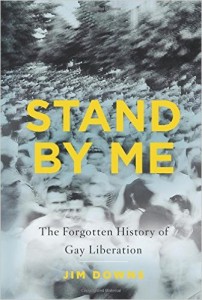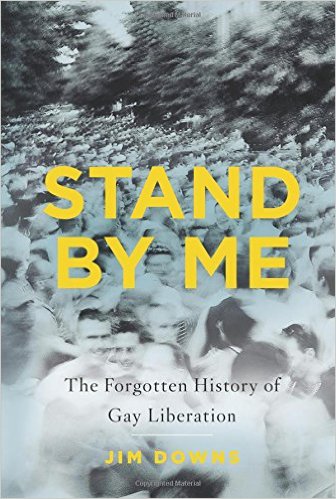 Stand By Me: The Forgotten History of Gay Liberation
Stand By Me: The Forgotten History of Gay Liberation
by Jim Downs
Basic Books. 272 pages, $28.99
THE PERIOD loosely called “gay liberation” is invariably thought of as falling somewhere between the buttoned-up climate of the 1950s and the emergence of AIDS in the ’80s, but for Jim Downs and many others, it ultimately comes down to the ’70s. Also, while the word “gay” was in current usage at this time, the era referred to as “gay liberation” involved lesbians, transsexuals, transvestites, and self-questioners as much as it did gay men.
Borne of extensive research in a number of community-based archives—primarily in Philadelphia, Los Angeles, New Orleans, and New York—Downs’ volume seeks to add complexity and nuance to our sense of the liberation period. He has uncovered much that is rare while also deploying others’ earlier findings. Downs makes a good case for us to remember that the zeal for liberation in the ’70s was deeply and directly informed by feminist politics, and thus was only ever in part, primarily or even strongly, about sexual liberation.
His first chapter concerns a 1973 arson attack on a building in New Orleans’ French Quarter, 141 Chartres Street. This venus hosted gay social events in its “Up Stairs Lounge”—including, one fateful Sunday, a meeting of the local branch of the Metropolitan Community Church (MCC). The fire claimed 32 lives and was described by Boston’s Gay Community News as “the greatest act of genocide against us since the witch burnings in Salem.” While nobody was ever charged, a hate crime does seem most likely. Downs calls it “the largest massacre of gay people in American history.” Notwithstanding his use of words like “massacre” and “genocide” to describe the event, Downs mediates the awful story skillfully, and properly references all his material. Still, the incident surely isn’t part of a “forgotten history”—particularly if you live in Louisiana. Clayton Delery-Edwards’s The Up Stairs Lounge Arson—published by McFarland as recently as 2014—built on the oral history research of local artist Johnny Townsend, itself collected in a self-published 2011 account, Let the Faggots Burn.
The next chapter follows smoothly, as the Revered Troy Perry, founder of the MCC, features in both. Downs’ retelling of the “gay religious movement” here illuminates an important corner of GLBT history. However, his account threatens to be derailed by a definite slant in the road. Downs is concerned to disclose the nonsexual side of gay liberation and disparages what he considers to be a post-AIDS focus on gay liberation in erotic terms as “a discourse that insists on promiscuous behavior to explain the spread of HIV.” That may characterize the writings of one or two popular historians—including Randy Shilts, whose unreliable And the Band Played On is positively cited—and a few creative writers, such as Larry Kramer, another of the handful of authors mentioned.
The reality was and is more complex. Edmund White’s revelatory travel narrative States of Desire: Travels in Gay America (1980, based on columns written for Christopher Street), may have been, in Paul Cowan’s dismissive review for The New York Times, “a journey through promiscuous, all-male America—a desolate place to live.” The present-day consensus, however, surely supports us reading White’s book as a groundbreaking endeavor: arguably, a work that created its own subgenre. Questions of religious belief, class, age, education, employment, politics, prejudice, regionality, social values, and family all play leading roles in it. But, of course, White’s interlocutors were for the most part sexually active gay men.
Downs seems to have a problem with sex. He argues that, “According to the logic of sexual promiscuity as the cause of HIV, it makes more sense [for others]to portray gay people at a disco than in a church pew, in a crowded bathhouse than at an ordination ceremony.” One knows what he’s getting at—and yet… The most moving scenes in AIDS narratives were, as I recall, set precisely among church pews. Norman René’s moving film Longtime Companion (1989) deftly took us from a ’70s Fire Island boardwalk to St. Vincent’s, and then, in seconds, from a hospital to a funeral service.
Downs’ own material too tells of the improbable and fascinating plurality of GLBT lives in the liberation period. Moments after the quotation above, he approvingly quotes one Larry Bernier, a gay Bostonian who became an MCC minister without renouncing his erotic feelings one bit: “There is no conflict for me in worshiping Jesus at service and then running out and sucking cocks at the Fenway.” Equally, one thinks, some gay men who attended the Continental Baths truly wanted to hear Bette Midler sing or Barry Manilow play. As the Divine Miss M herself said, “I feel like I was at the forefront of the gay liberation movement, and I hope I did my part to help it move forward. So, I kind of wear the label of ‘Bathhouse Betty’ with pride.” Personal and social histories are always complex and diverse. Thus, Downs legitimately argues against prejudiced reporting when he notes of the 32 arson victims: “These people were not lascivious or lewd.” At the same time, I cannot help asking: what difference would it make if they were?
Chapter three, perhaps the most substantive and moving, narrates the determination of a retail ingénue, Craig Rodwell, to found a gay bookstore in Greenwich Village: both to enable literary and cultural discussion and networking and, equally, simply to stock the sorts of titles people came to Manhattan looking for. And the Oscar Wilde Memorial Bookshop was born. Downs’ account—drawing on Rodwell’s papers at the New York Public Library—offers both information and inspiration. Wrote Rodwell back in the ’70s: “I am not a bookseller businessman. I am a person who at the age of 13 set out to help change the world and primarily Gay people’s self-images.”
Another “forgotten” niche was advocacy for gay and lesbian prison inmates (including from the MCC), notably efforts to encourage them to express themselves in verse. This is indeed an overlooked story, and a fascinating one. But again, Downs’ thirst for a strong narrative overtakes him. He concludes that by the late ’70s such collective initiatives were doomed, as “many gay people became more obsessed with themselves than with others or with their community. … New forums for community and cultural expression would begin to lose out as being gay became strongly connected to a particular—and barely attainable—body type for gay men.” One wonders, if he thought the ’80s narcissistic, what must Downs make of our contemporary world, with our digitalized lives, sex-focused websites, selfies, and social media?
A final chapter called “Body Language” pursues the myth of the perfectible gay clone in earnest. There is, however, the sense of a straitjacket being placed over what was a more diverse reality. The signature gay music group of the era, the Village People, made a point of emphasizing diversity through the various ethnic and occupational roles of its members. And the clone look was also resisted and ridiculed by at least as many gay or bi men as aspired to it. Some looked to Tom of Finland, others to Joe Brainard or Klaus Nomi.
Stand By Me is an uneven but diverting book with considerable virtues. Downs points to real opportunities for other social and cultural historians in the field, focusing on neglected archival resources. Its emphasis on the everyday and the somewhat overlooked (rather than “forgotten”) experience is a virtue, though the author ought to have resisted the lure of the bold headline or singular “narrative arc.” We were never only this or that, and most GLBT figures who made a difference aren’t entirely lost to us—or entirely remembered. As Downs himself notes in an atypical moment: “Gay people rethought the meaning of homosexuality in the 1970s, and their words, their language, and their ideas were often too sophisticated to be reduced to a catchy slogan on a sign at a pride parade.”
Richard Canning is the author of Gay Fiction Speaks (2001) and Hear Us Out (2004). He is the editor of Ronald Firbank’s Vainglory (2012).






